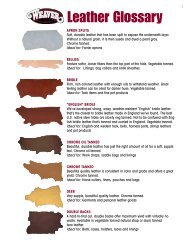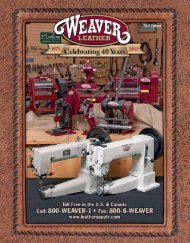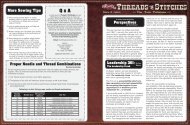Bitology - Weaver Leather
Bitology - Weaver Leather
Bitology - Weaver Leather
Create successful ePaper yourself
Turn your PDF publications into a flip-book with our unique Google optimized e-Paper software.
2<br />
Parts of a Bit<br />
• Purchase - The part of the bit that is located above the<br />
mouthpiece. With a short purchase, the bit will act quicker in<br />
a horse’s mouth when the rider pulls on the reins. With a long<br />
purchase, the bit is slower to react and works more on the poll.<br />
bars<br />
mouthpiece<br />
purchase<br />
shank<br />
cheek<br />
• Shank - The part of the bit that is located below the mouthpiece.<br />
It will give you leverage on the mouthpiece. The shorter<br />
the shank, the softer it is. The longer the shank, the more<br />
control you have.<br />
• Cheeks - This refers to the sides of the bit. The cheek includes<br />
both the purchase and the shank.<br />
• Mouthpiece - The mouthpiece goes in the horse’s mouth,<br />
across and on top of the tongue.<br />
• Bars - The bars of a bit rest on the bars of the horse’s mouth.<br />
The closer together the bars of the bit are, the more pressure is<br />
applied to the bars of the horse’s mouth.<br />
Types of Mouthpiece Metal<br />
Sweet Iron<br />
Sweet iron is intended to<br />
rust. It produces a sweet<br />
taste as rusting occurs to<br />
promote salivation.<br />
Copper<br />
Copper causes a horse’s<br />
mouth to salivate. This<br />
allows the mouth to<br />
stay soft and useable<br />
to the rider.<br />
Copper Inlay<br />
Like copper, a copper<br />
inlay encourages<br />
salivation and is often<br />
found on a sweet iron or<br />
stainless steel mouthpiece.<br />
Stainless Steel<br />
Stainless steel provides<br />
superior strength and a<br />
clean, neat look to any<br />
mouthpiece. A solid<br />
stainless steel mouthpiece,<br />
however, does not promote<br />
salivation and is best for<br />
horses with a consistently<br />
moist mouth. Stainless steel<br />
mouthpieces are available<br />
with copper inlays.<br />
Common Mouthpieces<br />
When it comes to mouthpieces, a general rule of thumb to follow<br />
is that the thicker the mouthpiece, the gentler it will be on your<br />
horse’s mouth. A thinner mouthpiece is more severe because the<br />
pressure it applies is focused on a smaller area on the tongue and<br />
bars. Remember, even the mildest mouthpiece can be damaging to<br />
a horse’s mouth in the wrong hands.<br />
Smooth-Mouth Snaffle<br />
Typically broken in the middle, this mild mouthpiece is gentle<br />
on your horse and helps to keep its mouth soft and responsive.<br />
It works on the corners of the mouth and the bars.<br />
Three-Piece Snaffle Mouth<br />
This mild mouthpiece is broken in two places which adds<br />
tongue pressure and allows the bit to work on the outside<br />
corners of the bars.<br />
Twisted Wire Snaffle Mouth<br />
Typically considered a mouthpiece with more authority, this should<br />
be used only in experienced hands. The twist creates rigid edges<br />
that can damage a horse’s mouth in the wrong hands. In the right<br />
hands, it can sharpen a horse’s responsiveness. We recommend<br />
this mouthpiece only be used by more advanced riders.<br />
Solid Mouth<br />
The firm feel of this type of mouthpiece allows more pressure<br />
to be applied to the tongue and bars than that of a broken<br />
mouthpiece. Be sure to find the right port that allows enough<br />
tongue relief for your horse.<br />
Correction Mouth<br />
Even though “correction” sounds like this could be harsh, the<br />
jointed action on these mouthpieces actually makes them milder<br />
than a solid mouth bit and allows your horse to feel signals before<br />
the bit completely engages. The port on correction mouthpieces<br />
is designed to provide tongue relief and work on the palate.







